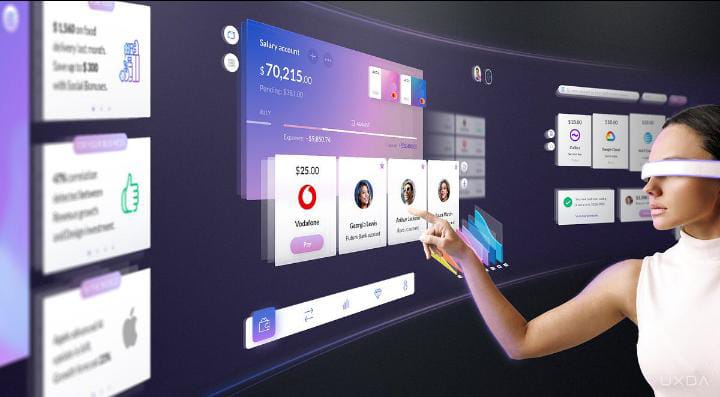
When we hear “spatial computing,” the mind may drift toward futuristic headsets and 3D visuals. Yet this emerging technology is now reshaping finance in transforming how Chief Financial Officers forecast, analyse, and strategize in a real-time, immersive environment. Combined with intelligent AI tools, it’s evolving CFOs into strategic operatives rather than mere number keepers.
Spatial computing overlays information onto the physical world or creates entirely virtual environments where users can manipulate data in three dimensions. It may sound like scientific fiction, but enterprises across industries, including finance, are already adopting it.
Deloitte, for instance, lists spatial computing among six pivotal technologies that aim to upend CFO responsibilities in the next 18-24 months. This is particularly because it merges operational and financial data for deeper insights and scenario modelling.
Imagine stepping into a virtual financial control room where cash flow, risk exposure, sales pipelines, and budget line items are floating in 3D. You can walk around them, rotate them, or pull layers apart to explore specific drivers. Aberdeen Group once found that companies using real-time data visualisation saw up to 15% improvement in cash from operations.
Spatial computing takes that visualisation even further. It invites expiration, collaboration, and interactive forecasting.
In this immersive space, CFOs aren’t just looking at numbers. They interact with scenario simulations such as testing new pricing structures, assessing the impact of supply chain shock, or stress-testing liquidity. All of these can be projected and manipulated live. Gartner anticipates that spatial computing will help organisations operate more effectively over the coming years, particularly when coupled with AI agents that anticipate user needs.
So how does this merge with the finance function of today? Let’s break it down into two interwoven trends: AI-driven smart finance and spatial computing interfaces.
AI-Driven Financial Operations: The Smart Backbone
Around the world, CFOs are integrating AI into core finance workflows such as forecasting, reporting, cash management, risk, and compliance. Survey data shows that around 42% of companies are experimenting with generative AI, with 15% making real investments in integrating it into strategy.
Platforms like Anaplan, Workday, Power BI Copilot, UiPath, and BlackLine now automate reconciliation, cash flow analysis, expense management, and anomaly detection. This frees humans from routine tasks so they can focus on strategic thinking.
AI forecasting tools continuously digest live sales, procurement, and macroeconomic data to update financial predictions. This means no more stale models. AI-powered scenario planning enables fast multivariable analysis, such as currency shifts or interest rate moves. This gives financial teams the ability to pivot quickly amid uncertainty.
Compliance and audit are among the most oversight-heavy domains in finance. AI can now autonomously flag anomalies, maintain audit trails, and continuously monitor for fraud in real time. These smart finance capabilities are foundational. When built into a spatial computing interface, they become interactive, tactile experiences.
Spatial Computing: The Immersive Interface for Smarter Strategy
Now imagine that AI-driven finance data visualised not on a flat dashboard but in an immersive digital plane. Spatial computing makes that possible. Physical and virtual worlds converge to give executives natural, intuitive insight into financial performance.
For example, financial advisors could use AR to project interactive portfolio visualisations into a client’s living room. They could walk clients through performance, risk metrics, and scenario outcomes. That immersive clarity builds trust and improves client engagement.
Internally, teams can collaborate in spatial computing workspaces. Imagine a shared virtual HQ where finance, operations, and strategy teams gather around 3D models of KPIs and run scenario simulations together. That accelerates insight, improves decision-making, and breaks down functional silos.
Major enterprise players such as SAP are already exploring spatial computing for financial strategies. Amazon Web Services executives describe the promise of “being served the right information at the right time with the right view.” Firms can test capital plans or portfolio impacts using digital twins that merge operational and financial layers.
Admittedly, hardware and implementation costs remain barriers. Spatial devices carry high price tags, integration across systems is complex, and workflows must be fundamentally reimagined. Privacy, data governance, and biometric security add another layer of complexity. Yet over time, as adoption spreads and costs fall, early adopters will command a strategic advantage.
Why Global Business Leaders Should Care
For CFOs and tech leaders, this is a competitive revolution. Those who harness AI-driven finance and spatial computing will:
- Improve cash flow visibility in real time,
- Run flexible, dynamic budgeting and stress testing,
- Communicate performance transparently to boards and investors,
- And elevate client engagement through immersive experiences.
Putting it simply, finance becomes not just functional, but transformational.
Wells Fargo’s CFO recently highlighted how AI is starting to automate even analyst report parsing and front-line tasks, freeing humans for higher-value judgment. As finance leaders shift from stewardship to strategic partnership, spatial computing offers the immersive toolkit to match that evolution.
Moreover, Deloitte emphasises that CFOs now must align innovation with financial strategy, manage costs, governance, and ROI for technologies like spatial computing. The winners will be those who can quantify real business value from immersive finance tools.
The Future is Immersive, and It’s Financial
Picture this: a CFO glides through an office-free world, surrounded by floating dashboards, animated cash flow waterfalls, real-time market feeds, and scenario simulators. Interactions feel tactile. Insights feel immediate. Strategy feels agile.
That’s not fantasy. That’s near-term reality. With AI enabling smarter forecasting, real-time risk monitoring, and automated compliance—and spatial computing bringing that intelligence into immersive form—finance is about to reimagine itself.
For business and technology owners anywhere, startups in Lagos to multinationals in London or Tokyo, the message is urgent. The next wave of competitiveness will come not from faster reports, but from smarter, more immersive financial logic. Step into the future. You’re already halfway there.